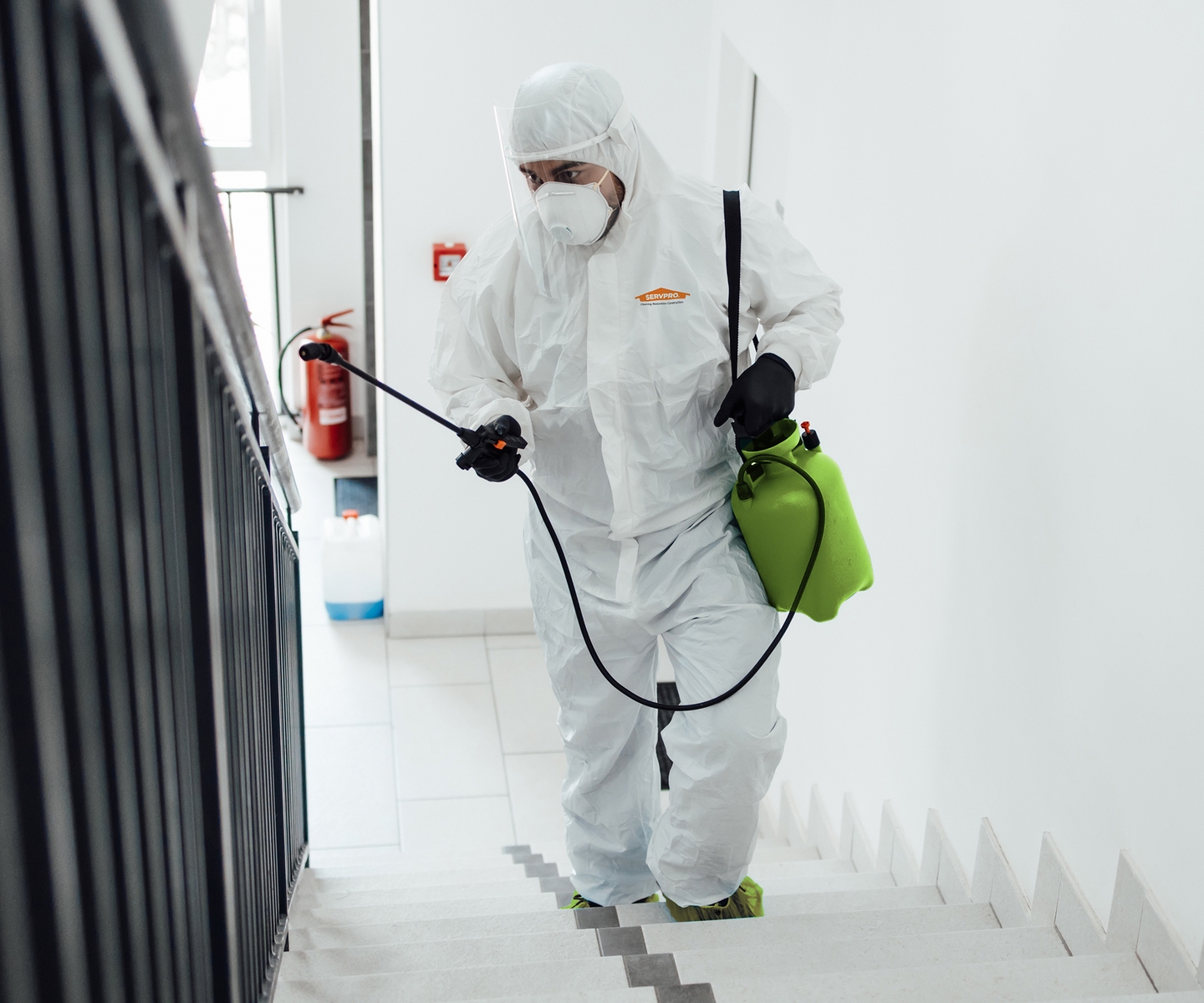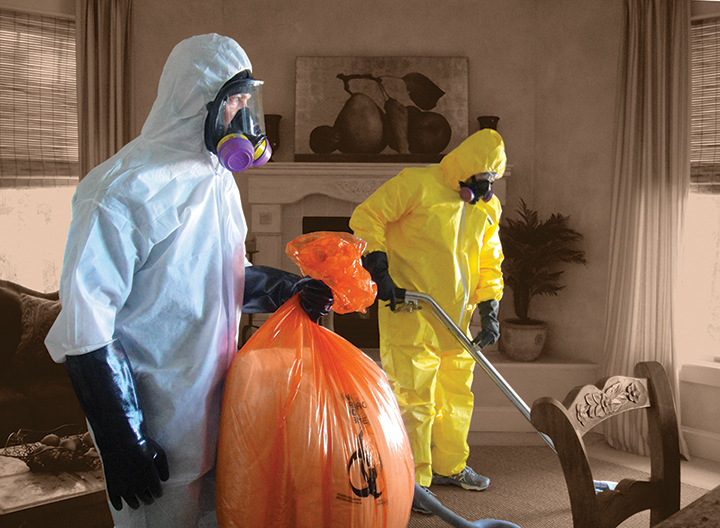Clandestine Lab Cleanup: Comprehensive Decontamination for Hazardous Sites
Clandestine Lab Cleanup: Comprehensive Decontamination for Hazardous Sites
Blog Article
Professional Biohazard Clean-up for Crime Scenes, Trauma Incidents, and Polluted Spaces
In the world of specialist biohazard cleaning, thorough attention to information and adherence to safety and security protocols are vital. As we dive into the details of biohazard clean-up for these sensitive settings, a much deeper understanding of the difficulties and essential treatments involved will arise, shedding light on the essential function of specialist clean-up solutions in recovering safety and security and peace of mind.

Value of Biohazard Cleaning
Biohazard cleanup complying with crime scenes and injury incidents is vital for ensuring the security of people and the setting. When these incidents happen, they commonly leave behind a range of biohazards such as blood, physical liquids, and various other potentially contagious products. These materials can harbor hazardous pathogens like germs and viruses, posturing severe wellness risks if not appropriately cleansed and sanitized.
Expert biohazard cleanup services are educated to take care of these dangerous materials securely and efficiently. They have the needed equipment, such as personal safety equipment and specialized cleaning agents, to completely sanitize the affected areas. By handing over the clean-up to skilled professionals, people can stay clear of exposure to dangerous virus and protect against the spread of infectious diseases.
In addition, appropriate biohazard clean-up is vital for safeguarding the setting. Incorrect disposal of biohazardous materials can contaminate dirt, water resources, and air, presenting a risk to wildlife and the environment. By following rigorous clean-up methods, experts can ensure that biohazards are safely gotten rid of and gotten rid of in accordance with laws, decreasing the danger of environmental contamination.
Kinds Of Biohazards Encountered
Various harmful materials generally come across in criminal offense scenes and injury occurrences present substantial health and wellness risks if not handled properly. Blood and physical fluids are amongst the most typical biohazards located in these situations.
An additional kind of biohazard commonly come across is sharp objects like needles, damaged glass, and other things that can create injuries and send infections. Chemical threats are also a problem, as crime scenes may have materials like tear gas, pepper spray, or drug production materials that require customized handling and disposal procedures to prevent further harm.
In addition, mold and mildew and microorganisms development can take place in rooms where decomposition or long term direct exposure to dampness has actually happened. These microbes can launch contaminants and irritants right into the air, posturing respiratory threats to those exposed. Overall, biohazard cleanup professionals must be fully equipped and qualified to efficiently handle these various kinds of unsafe products to make certain the safety and security of themselves and others.
Devices and Protective Gear
When addressing the vital job of handling biohazards experienced in crime scenes and trauma cases, the utilization of appropriate devices and safety gear is extremely important to guaranteeing the security of people involved in the cleaning process. Specialized cleaning devices like biohazard disinfectants, sharps, and bags containers are needed for the safe collection and disposal of polluted products. Ensuring that all devices is correctly maintained, routinely evaluated, and made use of according to security guidelines is important in lessening the danger of exposure to biohazards during cleanup procedures.
Cleaning Refine and Strategies
Complete and reliable cleaning of biohazardous materials from criminal offense scenes and injury cases needs careful attention to detail and adherence to rigorous security procedures. The cleanup procedure usually involves several vital have a peek at this site actions. At first, the area has to be assessed to determine the level of contamination and the appropriate cleansing strategies required. Next off, all biohazardous products, consisting of blood, bodily fluids, and tissue residues, need to be meticulously gotten rid of and dealt with based on local guidelines.
Complying with the elimination of biohazardous products, the affected location undergoes a complete cleaning and disinfection procedure. This step entails making use of specialized cleaning agents and devices to ensure that all traces of contamination are gotten rid of. After cleaning, the area undergoes rigorous screening to verify that it is cost-free and safe of any type of remaining biohazards.

Purification and Disposal Procedures
To guarantee complete decontamination and proper disposal of biohazardous products, following the precise clean-up process, details procedures need to be meticulously followed with stringent adherence to safety and security protocols. Decontamination entails the elimination or neutralization of contaminants to decrease the threat of direct exposure and spread of unsafe compounds. This procedure normally includes cleaning, sanitizing, and sanitizing the damaged location using customized tools and EPA-approved chemicals.
Once decontamination is finished, proper disposal of biohazardous materials is important to stop additional contamination or damage. Biohazardous waste, such as physical liquids or blood-soaked materials, have to be thoroughly gathered, packaged, and classified according to regulatory guidelines. ATP testing. These products are after that these details transported to qualified facilities for disposal through proper networks, ensuring conformity with local, state, and government policies

Conclusion
To conclude, expert biohazard cleanup is essential for ensuring the secure and reliable elimination of dangerous materials from criminal activity scenes, trauma events, and infected areas. By utilizing customized tools, protective equipment, and complying with proper cleaning processes and techniques, biohazard cleaning teams can efficiently sanitize and get rid of of biohazards, decreasing the threat of exposure and injury to individuals and the atmosphere.
As we dig into the complexities of biohazard cleaning for these sensitive settings, a deeper understanding of the obstacles and important treatments entailed will arise, losing light on the vital role of expert cleaning services in bring back safety and security and peace of mind.
Specialist biohazard cleanup services are educated to handle these harmful products safely and efficiently. By adhering to strict clean-up methods, specialists can ensure that biohazards are safely eliminated and disposed of explanation in conformity with regulations, lessening the threat of environmental contamination.
In general, biohazard clean-up specialists must be fully equipped and experienced to successfully take care of these numerous types of hazardous materials to guarantee the security of themselves and others.
When addressing the important job of taking care of biohazards encountered in crime scenes and trauma events, the use of correct tools and safety gear is critical to guaranteeing the security of individuals involved in the clean-up process.
Report this page